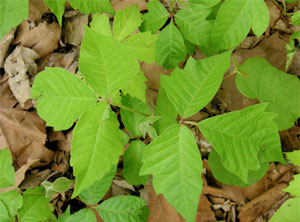Why does poison ivy cause a rash?
 Q: What is it about poison ivy that makes it cause such a bad rash?
Q: What is it about poison ivy that makes it cause such a bad rash?
A: Poison ivy, poison oak, and poison sumac are a group of related plants responsible for causing the most common “allergic reaction” in humans. Technically, the plants are not to blame. Rather, the agent responsible for the allergic reaction is the plants’ resin, urushiol, which in its natural state is a colorless oil that turns black when exposed to air (via an oxidation reaction).
The resin is not found on the surface of the leaves. Rather, it is found in the resin canals of leaves, stems, vines, berries, and roots of these plants. Why is this important? Because the plant parts containing the resin have to be injured enough so that they leak the resin. Then, you have to contact the resin directly.
Some good news: Dried leaves are less toxic because the resin has returned to the stem and roots through the resin canals.
Some bad news: Leaves are more fragile in the springtime – exactly when most people are “itching to go outdoors!”
Sensitivity to the resin varies from person to person, but you can become allergic to poison ivy, oak, or sumac at any age. Your risk for becoming sensitive to the resin actually increases with each exposure to it.
Some more good news: You have up to about 10 minutes after touching the resin to wash it off and, possibly, avoid a reaction.
Some more bad news: If you are too late, your skin will start to itch and turn red a few hours to a few days in the areas that contacted the resin. Eventually, the skin may swell and blister and may even weep and ooze.
An important clue that poison ivy, oak, or sumac caused the rash is the fact that it will often appear “in a line” on the skin, corresponding to where the resin rubbed against it! Some cases on the face have caused such bad swelling that people’s eyes have been swollen shut! Eventually, the rash begins to dry up in about 1 to 2 weeks. Sometimes, you will even see black dots in the skin corresponding to where the urushiol oxidized and turned black!
The resin from poison ivy, oak, or sumac can hang around for a pretty long time and can be spread from things like pet fur, clothing, tents, bike tires, walking sticks, etc.. Another very dangerous way of contacting the resin is through the smoke from burning poison ivy, oak, or sumac plants; the smoke particles can carry residual resin onto the skin and into the nose, mouth, throat and lungs, causing respiratory distress – a major medical emergency!
I know what causes it the rash.
The leaves have oils in them and when the oils come in contact with your skin it makes your skin red.
thanks
I have poison ivy for almost three weeks now it so bad that my skin where it was at is now a shade black that my skin look dirt it so dark around my neck eye lids and stomach
what does it cause
Hey! Thanks for the great info. I have ben looking for something like this for a while now.